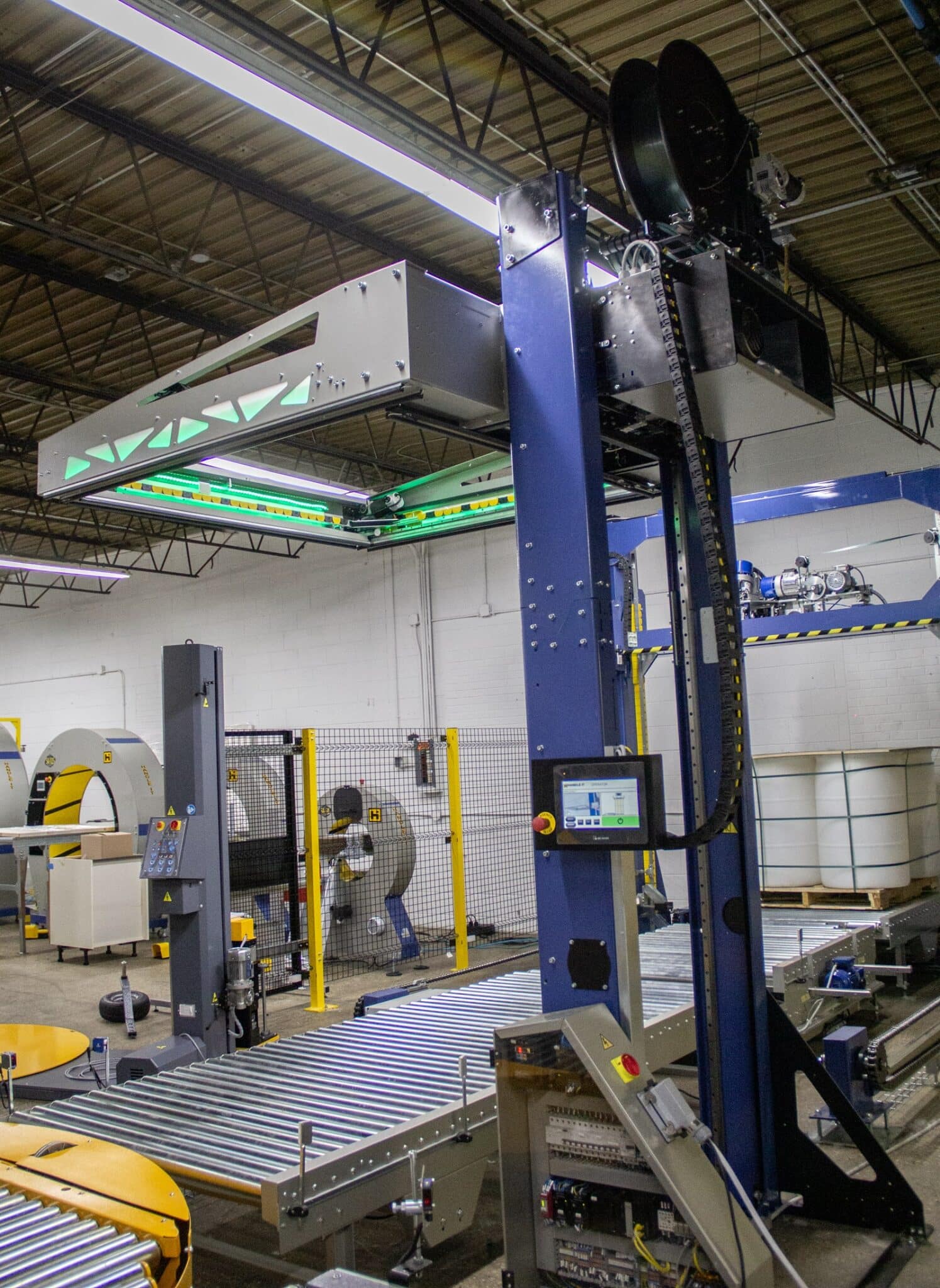
Selecting the right strapping system is a common challenge for many businesses. Companies often struggle with product type, environmental conditions, and budget constraints.
This process can be frustrating, as the wrong choice may lead to inefficient operations and damaged goods. The complexity of the decision can leave managers feeling overwhelmed and uncertain about the best path forward.
Fortunately, there are effective ways to approach this decision. Understanding different strapping materials, methods, and equipment is crucial for finding the optimal solution.
Read on to learn more about choosing the right pallet strapper so you can make a more informed buying decision.
It’s essential to first understand your application’s specific requirements. This includes evaluating the load characteristics, environmental conditions, and how the load will be handled and transported.
Measure the load’s weight and dimensions to determine the required strapping strength. Uniformly shaped products work best with standard strapping machines. Irregular shapes might need specialized machines or adjustments.
For example, steel strapping suits heavy machinery, while smaller packages may need polyester or polypropylene.
Consider where the strapping will be used (indoors or outdoors) and if it will face moisture, UV light, or chemicals. This helps in selecting materials that can adequately handle these conditions. Also, check available space for an automated system and ensure it will integrate smoothly with other equipment.
Decide how the strapped loads will be handled—manually or by automation. This choice impacts whether a manual, semi-automatic, or fully automatic system is best.
For example, products transported by truck need strapping characteristics that are different from those shipped internationally. Make sure the system can handle these transport conditions.
Different strapping materials offer various benefits depending on the application. Understanding these materials helps you select the right one for your needs.
Steel strapping is the most robust option for heavy-duty and sharp-edged loads. It is highly durable but prone to rust and requires regular maintenance. Though it has a higher initial cost, its strength and longevity make it suitable for industrial uses like steel coils. Many industries are transitioning from steel strapping to polyester PET due to its advantages in maintenance, cost-effectiveness, and safety.
Polyester (PET) strapping offers good strength and flexibility, and is less expensive than steel. It resists rust and corrosion and is 100% recyclable. Vertical strapping typically uses PET straps due to their strength and resistance to stretching. Horizontal strapping often employs PP straps, but you can also use PET.
Polypropylene strapping is lightweight and cost-effective, suitable for lighter loads and indoor use. Compared to PET, it is less durable and harder to recycle. Due to its lower cost and ease of use, this type of strapping is typically used for horizontal strapping of lighter packages.
Type of Sealing Method
Depending on the type of strapping material, and the equipment used, straps can be sealed in three main methods.
Metal Seals
Metal seals are used exclusively for steel strapping. It involves placing a seal over the overlapping strap ends and compressing it to secure the strap. It is a strong, reliable seal for loads requiring the extra durability of steel straps.
Friction Welding
Friction welding seals the strap using motors that generate vibrations, creating heat from friction which melts and fuses the strap ends together. This method provides a strong, reliable seal without the need for external heat sources or additional materials. It is ideal for high-volume operations where speed and consistency are crucial.
Thermo Welding
Thermo welding, also known as heat sealing, resistance welding or thermoseal, seals the strap using a heat source, such as a thermoprobe, to melt and fuse the strap ends. Effective for a variety of plastic straps and known for producing strong, durable seals, thermo welding is particularly useful in environments where precise control over the sealing process is necessary, ensuring uniformity and strength in each seal.
Several general factors can significantly impact performance and safety.
Your strapping system should comply with industry standards, such as ASTM for steel strapping. Meeting these standards guarantees safety and performance. Different industries, like automotive or food processing, have specific requirements that the system should meet.
Assess the tension needed to keep the load stable during transport and storage. Proper tension is essential for maintaining load security. Strapping systems should handle varying tension requirements depending on the load’s stability.
Choose a strapping method and material that offers safety for both the load and the handlers. Evaluate the safety features of different systems, including protective mechanisms and ease of operation. The system should be safe and suited to the operational environment.
Incorporating safety fences and security systems is important to protect people from potential hazards. The strapping system should include safety features and protocols to prevent accidents and injuries.
Selecting the appropriate strapping option is crucial for efficiency and effectiveness. Different types of strapping equipment offer varying levels of performance and cost. Consider manual versus automated operation factors to determine which choice best suits your needs.
Manual systems rely on human effort to operate strapping equipment. They are often less expensive but require more labor and can lead to inconsistencies in quality. Automated setups use machinery to perform strapping tasks.
They offer higher efficiency and consistency, making them ideal for high-volume environments. While involving a higher initial investment, automated systems reduce labor costs and improve accuracy.
Manual strapping systems are affordable and straightforward. They work well for low-volume applications where flexibility is needed. However, depending on the operator’s skill, they are slower and more labor-intensive. Although more affordable upfront, there is the long-term cost/risk of employee safety
Semi-automatic systems offer higher production rates than manual systems and are more portable. They are suited for medium-volume applications where automation is beneficial but not entirely justified. Due to their complexity, these systems still require some labor and can be costly to maintain. Semi-automatics are usually only used for smaller items.
Fully automatic strapping systems provide high production rates with minimal labor. They are best for high-volume operations needing consistent throughput. Despite their higher initial cost, they streamline the strapping process by automating the feeding, tensioning, sealing, and cutting of straps, reducing the need for manual labor and minimizing the potential for human error. They speed up the packaging process, ensuring consistent strap tension and seal quality, leading to improved load stability and reducing downtime. Fully automatic strapping machines can handle high volumes of pallets with minimal supervision, making them ideal for large-scale operations.
Evaluating the cost of strapping options is essential for budget planning. Assess the initial investment and ongoing expenses to ensure the selected system aligns with financial goals.
Compare the initial costs of strapping tools or machines and the materials used. Long-term benefits, such as increased durability and efficiency, may justify higher upfront costs. For instance, automated systems might have higher initial costs but offer better long-term value.
Consider ongoing costs for maintenance, material replacement, and labor. Automated systems often lead to labor savings and increased productivity, which can offset their higher initial costs. Evaluate the total cost of ownership, including maintenance and operational expenses.
Analyze potential savings from reduced labor costs and improved productivity with automation. Calculate the return on investment by considering labor savings, injury reduction, and overall efficiency gains. Automated systems can provide substantial cost savings and enhance operational efficiency.
Effective testing and validation ensure the reliability of strapping solutions. Conduct trials to verify performance and confirm that the chosen system meets your requirements.
Perform trial runs to test the strapping system under actual working conditions. Make sure the system meets performance expectations and handles different load types effectively. Testing should include various environmental conditions to confirm system reliability.
Gather feedback from operators and stakeholders to refine the system. Use this input to make adjustments and improve performance. Address any issues discovered during trials so that the system fully meets your needs.
Reliable support and service from suppliers play a key role in maintaining strapping equipment. Evaluate their ability to provide timely assistance and ongoing support.
Select a supplier with a strong reputation and experience in producing reliable machinery. Ask about their use of up-to-date technologies and check if the equipment requires proprietary components. A reputable supplier will provide dependable and effective solutions.
Verify that the supplier offers comprehensive support, including installation, training, and maintenance. Access to quick replacement parts is essential for minimizing downtime. Ensure that the supplier provides robust support to keep your system running smoothly.
Assess how well the new system integrates with your current setup and its impact on material flow and space. The new system should fit seamlessly into your existing workflow without causing disruptions. Compatibility with existing equipment is important for efficient operations.
Review the warranty terms and the supplier’s service approach. A strong warranty and responsive service can save time and costs in the long run.
Handle It has created a checklist to help you assess your specific strapping system needs. It will help you consider all factors and make an informed decision that aligns with your business objectives and operational requirements.
Download our Strapping Equipment Checklist
Choosing the right strapping system helps you achieve performance, efficiency, and safety. The strapping experts at Handle It will review your unique packaging and stacking process and guide you toward the best solution.
Handle It offers a comprehensive range of strapping machines that we can customize to meet your unique needs. Click below to explore our horizontal and vertical strapping systems in depth to make a more informed decision.
BACK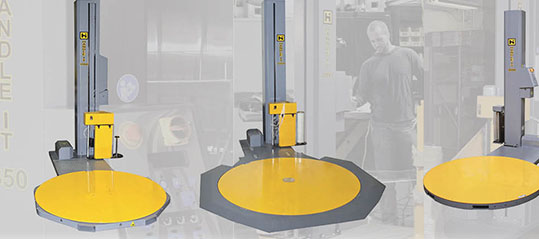
Shop our wide variety of pallet wrapping machines and stretch wrappers to improve your current packaging process.
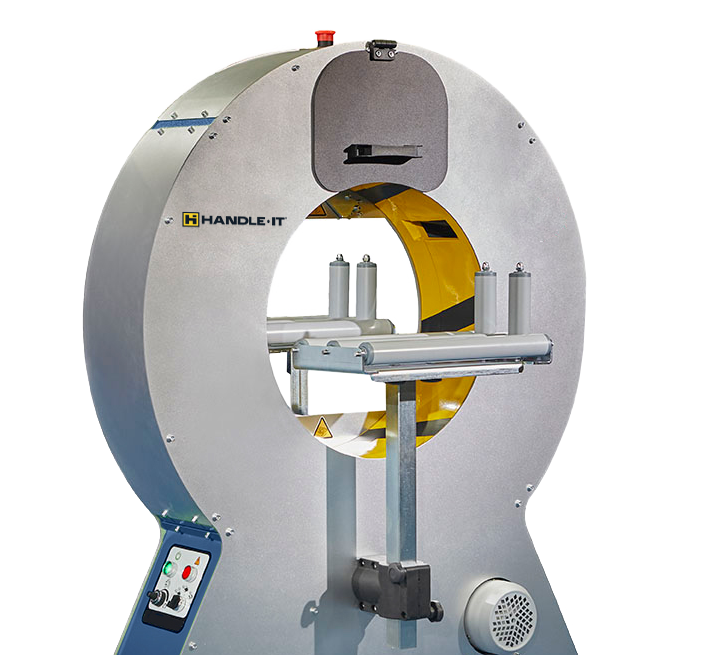
Shop our several types and sizes of orbital wrapping machines to meet your horizontal product bundling needs.
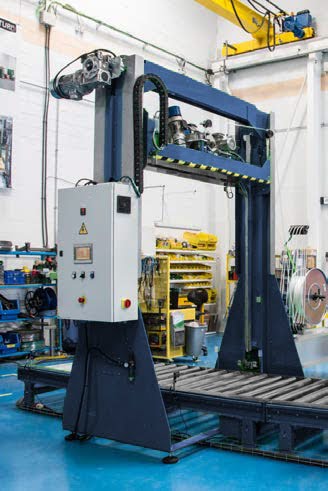
Shop our pallet strapping equipment to secure your products for safe and reliable transport.
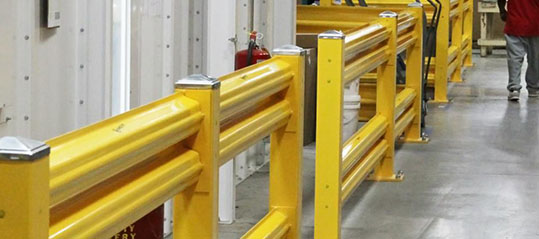
Shop our guard rail systems and components to improve the safety of the people, structures and items in your warehouse.
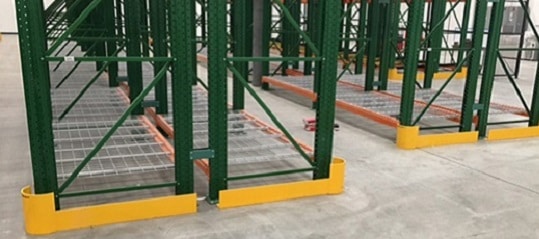
Shop rack & post protectors to decrease the damage to your pallet racks and posts due to impact from forklifts and pallets.